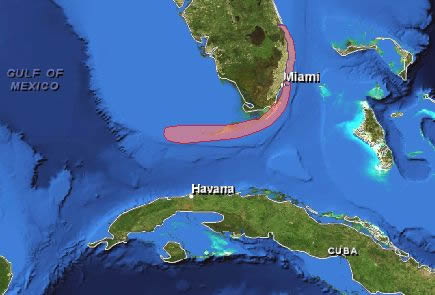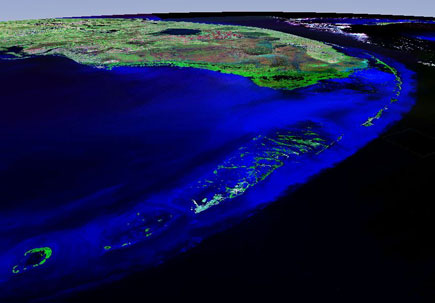-
Home
-
Data & Publications
-
Regional Portals
- About Regional Portals
- Florida
- Navassa Island
- Puerto Rico
- Flower Garden Banks
- U.S. Virgin Islands
- American Samoa
- Commonwealth of the Northern Mariana Islands
- Federated States of Micronesia
- Guam
- Main Hawaiian Islands
- Republic of the Marshall Islands
- Northwestern Hawaiian Islands
- Republic of Palau
- Pacific Remote Island Areas
-
CRCP Activities
- Glossary
Florida
Florida is the only state in the continental United States to have extensive shallow coral reef formations near its coasts. These reefs extend over 300 miles from the St. Lucie Inlet in Martin County, to the Dry Tortugas in the Gulf of Mexico. The most productive reef development occurs seaward of the Florida Keys, and the most extensive living coral reef in the United States is adjacent to the island chain of the Florida Keys. The Florida Reef Tract possesses coral formations very similar to those found in the Bahamas and Caribbean Sea.
All but the northernmost extent of the reef tract lies within the boundaries of the Florida Keys National Marine Sanctuary. The 2,800 square nautical mile Florida Keys National Marine Sanctuary (FKNMS), designated in 1992, surrounds the entire archipelago of the Florida Keys and includes the productive waters of Florida Bay, the Gulf of Mexico and the Atlantic Ocean. Discontinuous and less biologically diverse coral reef communities continue northward along western Florida shores to the Florida Middle Grounds, a series of submerged pinnacles rising to within 60-80 ft of the surface, about 100 miles northwest of St. Petersburg.
In addition to local residents, millions of tourists travel to Florida to enjoy scuba diving, snorkeling, and fishing on south Florida's coral reefs. These activities provide a great source of income for Florida and its coastal communities. It is estimated that coral reef activities in Martin, Palm Beach, Broward and Miami-Dade counties generate $3.4 billion in sales in general and income and support 36,000 jobs in the region each year.
Since 2014, Florida's coral reefs have been experiencing a multi-year outbreak of Stony Coral Tissue Loss Disease. While disease outbreaks are not uncommon, this event is unique due to its large geographic range, extended duration, rapid progression, high rates of mortality and the number of species affected. The disease can be transmitted to other corals through direct contact and water circulation. Researchers are working to identify potential pathogens and relationships with environmental factors, strategies to treat diseased colonies, and identify genotypes of corals that are resistant to the disease.

Florida location map

Florida satellite map
Highlights
OCM Coastal Impact Stories: Coral Reef Conservation Program in Florida
Publications
Florida's Coral Reef Management Priorities (2010)
Florida Capacity Assessment Report and Coral Reef Conservation Timeline
A cooperative multi-agency reef fish monitoring protocol for the Florida Keys coral reef ecosystem. Natural Resource Report NPS/SFCN/NRR-2009/150
Southeast Florida Coral Reef Fishery Independent Baseline Assessment 2012-2014 Summary Report
An Integrated Biogeographic Assessment of Reef Fish Populations and Fisheries in Dry Tortugas : Effects of No-Take Reserves - NOAA Technical Memorandum NOS NCCOS 111
Mapping Southern Florida’s Shallow-water Coral Reef Ecosystems: An Implementation Plan
Socioeconomic Impacts of Marine Reserves - Tortugas Ecological Reserve
A Socioeconomic Study of Reefs in Southeast Florida, Final Report - October 19, 2001
Report on the Status of Marine Protected Areas in Coral Reef Ecosystems of the United States. Volume 1: Marine Protected Areas Managed by U.S. States,Territories, and Commonwealths. NOAA Technical Memorandum CRCP 2 February 2007
Can marine “protected” areas be effective?
State of The Reefs report (SOTR)
The State of Coral Reef Ecosystems of the United States and Pacific Freely Associated States: 2008.
The State of Coral Reef Ecosystems of the United States and Pacific Freely Associated States: 2005.
The State of Coral Reef Ecosystems of the United States and Pacific Freely Associated States: 2002.
Local Action Strategy
Florida Local Action Strategy Factsheet
Southeast Florida Coral Reef Initiative: A Local Action Strategy
Management Activities
Florida Reef Tract Coral Bleaching Response Plan
Climate Change Action Plan for the Florida Reef System 2010-2015
Our Florida Reefs Community Planning Process
Stony Coral Tissue Loss Disease Response
Metadata, Data and Publications search in CoRIS
Search the CoRIS Geoportal for Florida metadata, data and publications
Reef Base Coral Bleaching Reports
Select "U.S. Caribbean" in the Region window and " Florida (USA)" in the Country window
Real Time and Near-Real Time Monitoring Data
Coral Reef Watch Satellite Monitoring
Coral Reef Watch - Florida Keys
The Global Temperature-Salinity Profile Program
NOAA/National Weather Service - Data from Florida
NOAA CO-OPS - Tide Data
- 8728690 Apalachicola, FL
- 8720376 Dames Point Bridge Air Gap, FL
- 8725520 Fort Myers, FL
- 8722670 Lake Worth Pier, FL
- 8725110 Naples, FL
- 8729108 Panama City, FL
- 8720625 Racy Point, St Johns River, FL
- 8726520 St Petersburg, FL
- 8723214 Virginia Key, FL
- 8727520 Cedar Key, FL
- 8720219 Dames Point, FL
- 8720357 I-295 Bridge, St Johns River, FL
- 8720218 Mayport (Bar Pilots Dock), FL
- 8726607 Old Port Tampa, FL
- 8729840 Pensacola, FL
- 8720503 Red Bay Point, St Johns River, FL
- 8721604 Trident Pier, FL
- 8726724 Clearwater Beach, FL
- 8720030 Fernandina Beach, FL
- 8724580 Key West, FL
- 8729210 Panama City Beach, FL
- 8726384 Port Manatee, FL
- 8720226 Southbank Riverwalk, St Johns River, FL
- 8723970 Vaca Key, FL
NOAA Tide Predictions - Florida
Cheeca Rocks Ocean Acidification Monitoring Buoy
Other Data & Information
Historical Atlas of Southern Florida Shallow-water Benthic Habitats (1991)
South Atlantic Deep Coral Assessment - Deep Coral Cruise Data
Continuous bottom temperature measurements in strategic areas of the Florida Reef Tract
Florida Environmental Sensitivity Index (ESI) Files
USGS Projected Flood Extent for Florida
Education and Outreach
Aquarius Reef Base - Education and Outreach
Florida Department of Environmental Protection - Coral Reef Conservation Program
Florida Reef Tract Coral Disease Outbreak
Florida Fish and Wildlife Research Institute
South Florida Water Management District
The South Florida and Caribbean Cooperative Ecosystems Studies Unit (SFC CESU)
University of Miami Rosenstiel School of Marine and Atmospheric Science - Coral Reef Futures Lab
NOAA Ocean Service - Corals Tutorial
Marine Protected Areas/ Marine Managed Areas (MPA)
Electronic Code of Federal Regulations: Fisheries of the Caribbean, Gulf, and South Atlantic
Marine Protected Areas of the United States Home Page
The Marine Protected Areas Inventory
Marine Federal Areas Fact Sheet
Executive order 13158: Marine Protected Areas
Archie Carr National Wildlife Refuge
Florida Keys National Marine Sanctuary
Fish and Wildlife Service National Wildlife Refuges (Florida)
Florida Middle Grounds Habitat Area of Particular Concern
Nathaniel P. Reed Hobe Sound National Wildlife Refuge
J.N. "Ding" Darling National Wildlife Refuge
John Pennekamp Coral Reef State Park
Key Largo National Marine Sanctuary Outstanding Florida Water
Key West National Wildlife Refuge
Key Deer National Wildlife Refuge
Reef Fish Longline and Buoy Gear Restricted Area
Reef Fish Stressed Area
Ten Thousand Islands National Wildlife Refuge
Virginia Key No Entry Zone


